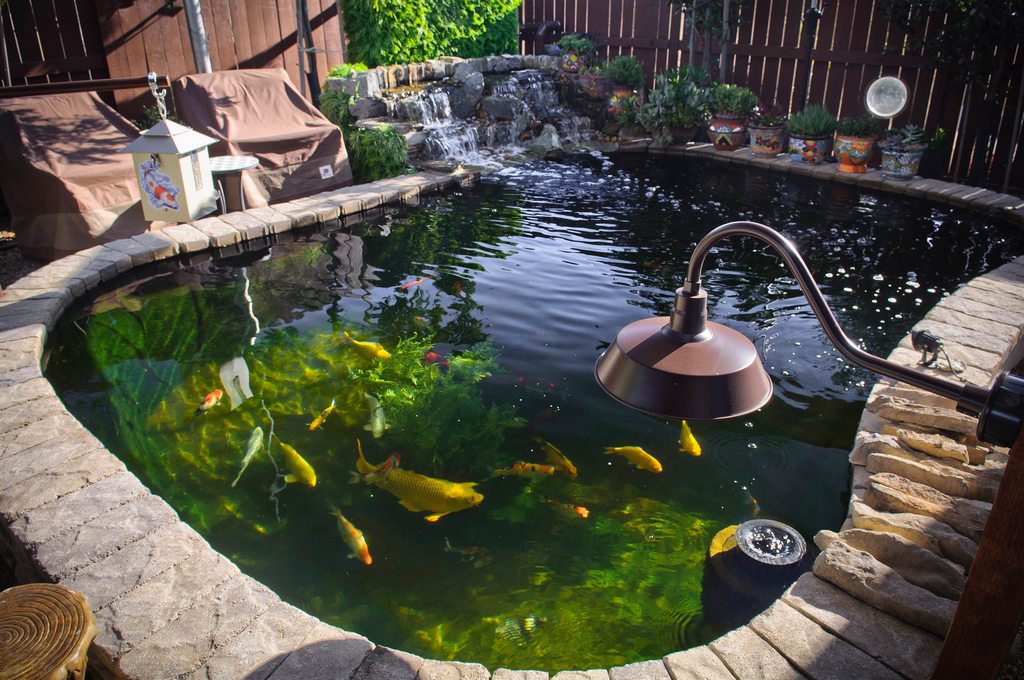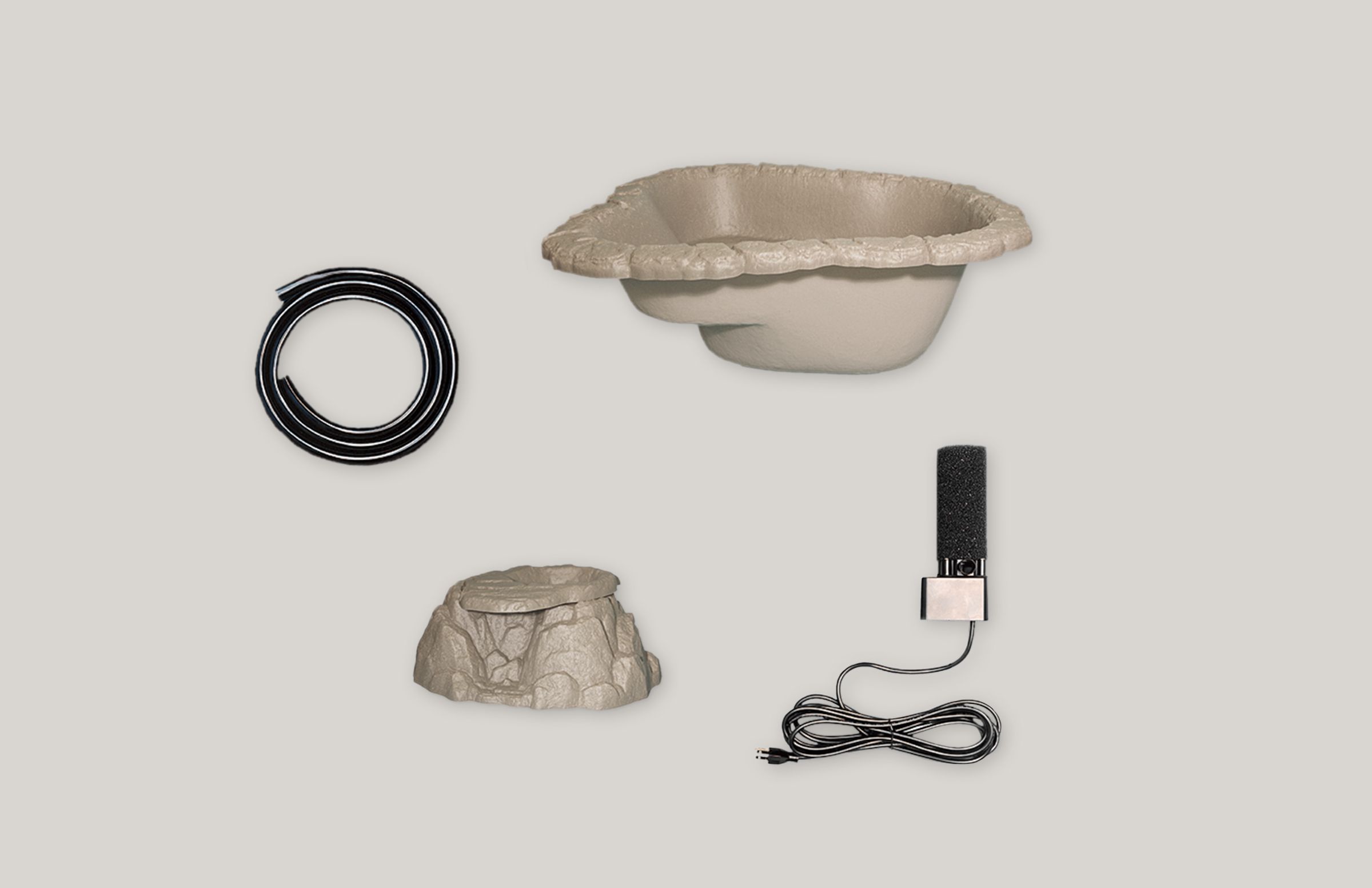Want to introduce an attractive new dimension to your landscape? Just add water. The experts at This Old House talk about how to make a beautiful, well-kept water feature for your backyard.
There’s something about water in motion that soothes the soul. Watching light play off the ripples or listening to the splash of a fountain—these are universally calming pastimes. So it shouldn’t be a surprise that adding a pond is one of the most popular landscaping projects for people who read This Old House.
Happily, you don’t need deep pockets or lots of land to enjoy your own water feature. If you do your own digging, you can put in a fully equipped, landscaped, fish-filled pond for about $500. To make a lush environment like the one on the right, you need rubbery liners, strong pumps, good filters, and, of course, a promise to take care of them. No matter where you put it in your yard—near a deck or patio, in a corner, or somewhere else—when you’re done, your pond will always be interesting to family and guests.
Having your own backyard fish pond is a great way to add beauty and serenity to your outdoor space. A fish pond not only looks aesthetically pleasing, but also serves as a lovely spot for relaxation. Watching the fish swim around can have a meditative, calming effect And the melodic sound of a water fountain or waterfall adds tranquil ambience to the yard
Building a backyard fish pond is a fun weekend project that you can tackle yourself without too much difficulty. With some planning the right materials and a bit of work, you’ll have a gorgeous pond up and running in no time. Here is a step-by-step guide on how to build your own backyard fish pond.
Choose the Location
The first step is deciding on the right spot in your yard for the pond. Some key factors to consider when picking the location:
-
Sun exposure – Most fish and pond plants thrive best with about 5-6 hours of direct sunlight per day Avoid overly shady spots
-
Access to utilities – You’ll need access to electrical and water supply for things like pumps, lighting and filling up the pond.
-
Visibility – Pick a spot where you’ll be able to see and enjoy the pond. Near a patio or deck is ideal.
-
Potential leakage – Avoid areas with extremely sandy soil or a high water table, as this increases risk of leakage.
-
Trees/falling debris – Don’t position it directly under trees, or you’ll constantly be cleaning out leaves, flowers, etc.
Once you’ve selected the spot, mark it off and remove any grass or plants by digging them out.
Size and Shape
Now decide on the approximate size and shape for your pond. Small backyard ponds can be anywhere from 100-500 gallons. Match the dimensions to the space you have available.
Kidney shaped ponds are most popular as they look natural. You can also do oval, round or freeform shapes. Draw an outline with a garden hose to visualize the shape and make adjustments as needed.
In terms of depth, make the deepest part of the pond around 2-3 feet deep so fish can survive the winter months. Sloping the sides up provides more shallow areas for plants.
Digging the Pond
Time to start digging! Outline your pond shape and start removing dirt to slope the sides downwards to the deepest point. Use stakes and string tied across to check your progress and ensure the sides are even.
As you dig, pile the dirt around the outer edges to use later for creating a raised berm around the perimeter. This berm will help contain the liner and prevent overflow.
Remove any sharp rocks or sticks from the dirt walls with a rake. Smooth out bumps for a nice flat surface.
Pond Liner
Now add a pond liner to create a waterproof barrier that holds the water. Pond liners are made of rubber or PVC materials. Measure the entire area of the pond to determine the size needed. Allow for plenty of overlap beyond the edges.
Add some sand or padding material on the bottom for a protective underlayment. Gently place the liner in the hollow space with the padded side down. Carefully spread it out without dragging so it lays smoothly across the dirt.
Mold the liner to the contours of the hole, pressing it into edges and sides. Then trim off any excess liner, leaving at least a 12” border around the top. Weigh down the edges with flat rocks to keep the liner in place.
Fill with Water
It’s time to start filling the pond with water! Place a hose in the lowest part of the pond and turn on the tap, filling slowly. As the water level rises, smooth out any wrinkles and adjust the sides and edges so the liner hugs the dirt snugly.
Once the pond is filled, install an aquatic pump and tubing according to the manufacturer’s instructions. The pump will circulate and filter the water to keep it clear and healthy for fish.
Add Finishing Touches
Here are some final touches to complete your pond:
-
Build up a berm around the top edges with the leftover dirt and smooth it out evenly. This contains the liner and water. Plant grass or mulch on top of the berm for a finished look.
-
Hide the liner with rocks and gravel around the inner edges. Arrange them aesthetically. Larger rocks look nice on the outer perimeter and bottom.
-
Get some aquatic plants and partially submerge them in pots. This adds beauty, helps filter water, and gives fish hiding spots. Popular choices are water lilies, irises, cattails, and water hyacinths.
-
Install a water fountain, waterfall or bubbler. The pleasant trickling sounds will make your pond even more relaxing.
-
Consider lighting like underwater LED lights or spotlights pointed at the pond. This allows you to enjoy your water feature day and night.
Introducing Fish and Plants
Once your pond is completely filled and all equipment installed, it’s time to add some fish! Here are some tips:
-
Let the pond run for 1 week before adding fish. This allows the water to adjust and stabilize.
-
Start with just a few hardy fish like koi, goldfish or fathead minnows. Wait to add more sensitive tropical fish.
-
Acclimate the fish slowly to avoid shock. Float their bags in the pond so the fish can adjust to the temperature.
-
Add aquatic plants from reputable dealers. Ask for low-maintenance, non-invasive varieties suitable for backyard ponds.
-
Introduce plants and fish gradually over several weeks. This gives the pond ecology time to establish balance.
Pond Maintenance
Proper maintenance keeps your pond clean, healthy and sustaining life. Expect to spend about 30 minutes per week on upkeep. Here are some key maintenance tasks:
-
Use a skimmer net to remove fallen debris like leaves frequently. Excess debris pollutes the water.
-
Clean the pump filter regularly according to manufacturer instructions to remove trapped gunk and debris.
-
Prune back overgrown plants and remove dead leaves/stalks. Discard excess plant matter if it accumulates.
-
Use an algae treatment product if green algae overgrows the pond. Prune affected plants.
-
Test and adjust water chemistry with products like pH adjuster and water clarifier as needed.
-
Top up water weekly to replace amounts lost naturally through evaporation. Add water gently to avoid disrupting fish.
-
Clean the pond sides with a algae scrub brush and remove accumulated green/black algae growth.
-
In cold climates, install a pond de-icer to prevent ice over and allow proper gas exchange during winter months.
Troubleshooting Common Pond Issues
Even with proper maintenance, you may encounter some occasional issues with your backyard pond. Here are some common problems and how to fix them:
Cloudy green water: Caused by single-celled algae suspended in the water. Treat with algaecide and clean pump filter frequently. Reduce sunlight exposure if excessive.
Stringy green hair algae: Aggressive algae, remove manually and spot treat affected areas with algaecide. Improve water circulation.
Leaking water: Check liner for tears and patch leaks with underwater repair tape. Refill lost water.
Fish gasping at surface: Low oxygen levels – increase aeration and water circulation. Check for clogs in tubing.
Pump not working: Clean out intake, check circuit breaker. Replace impeller or motor if necessary.
Fish dying: Get pond water tested and correct any chemical imbalances. Look for predators and treat pond with natural treatments if found.
Building your own backyard fish pond is a very rewarding project that anyone can do with some effort. Following the steps outlined, like choosing the right spot, digging the hole, installing the liner and equipment, adding plants/fish, and regular maintenance, you’ll be enjoying your own beautiful backyard pond in no time. Just be prepared for some ongoing care, and your pond will provide many years of beauty and serenity.

How long do they last?
It all depends on the liner. The best ones have a 20-year warranty and 30- to 40-year life span.
The electricity to run a pump for a typical 176-square-foot pond costs about $260 a year. Filters need frequent cleaning. A pond-maintenance firm starts at about $1,000 a year.
The location of a pond determines its health and your ability to enjoy it.
Backyard Pond DIY Kits

Most online retailers bundle the pond essentials. You can also buy a home center kit that already has a rigid plastic tub, flexible tubing, and a pump that is the right size. These kits are small and easy to put together over the weekend, but they don’t come with the biological filter that fish need.
Though you could add a filter like that, they’re really just low-maintenance water features for people who want the sound of water trickling next to their deck or patio. They’re not meant to be full-on ecosystems.
Building a BACKYARD FISH POND!! (cheap & easy)
FAQ
How deep should a backyard pond be for fish?
How much does it cost to build a small pond in your backyard?
